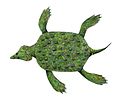| Microcleidus Temporal range: Toarcian ~ | |
|---|---|
 | |
| Fossil M. homalospondylus | |
| Scientific classification | |
| Kingdom: | Animalia |
| Phylum: | Chordata |
| Class: | Reptilia |
| Superorder: | † Sauropterygia |
| Order: | † Plesiosauria |
| Superfamily: | † Plesiosauroidea |
| Family: | † Microcleididae |
| Genus: | † Microcleidus Watson, 1909 |
| Type species | |
| Plesiosaurus homalospondylus (Owen, 1865) | |
| Other species | |
| |
| Synonyms | |
M. macropteus
M. tournemirensis
| |
Microcleidus is an extinct genus of sauropterygian reptile belonging to the Plesiosauroidea. The species has 40 neck vertebrae and a short tail of 28 vertebrae. Fossils of the genus have been found in France, the Posidonia Shale in Germany and Luxembourg, and the Alum Shale Formation of England.








